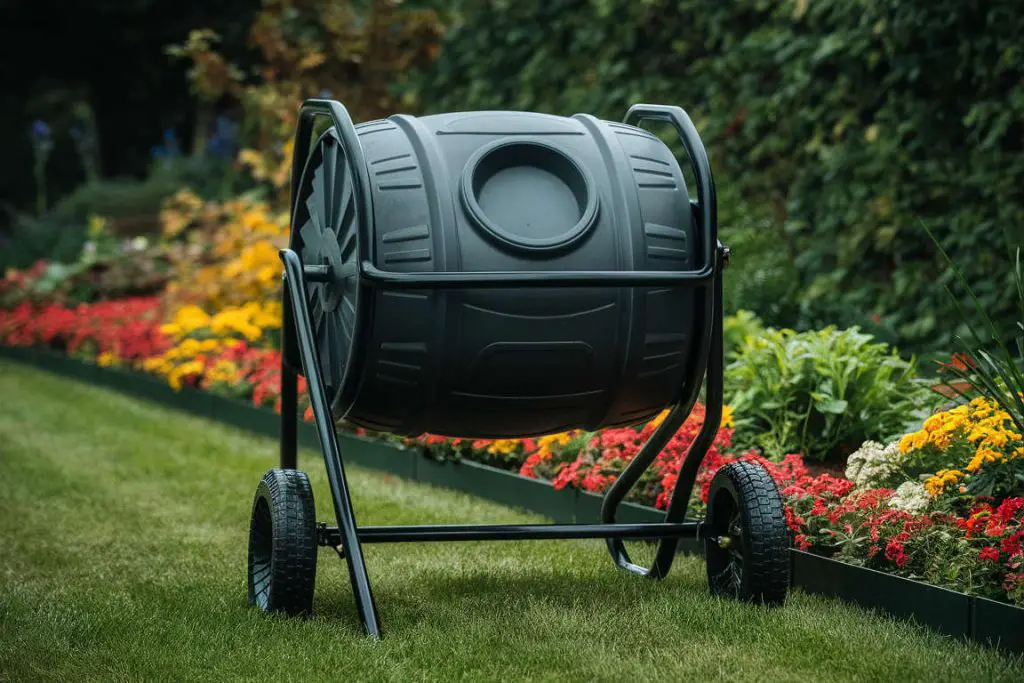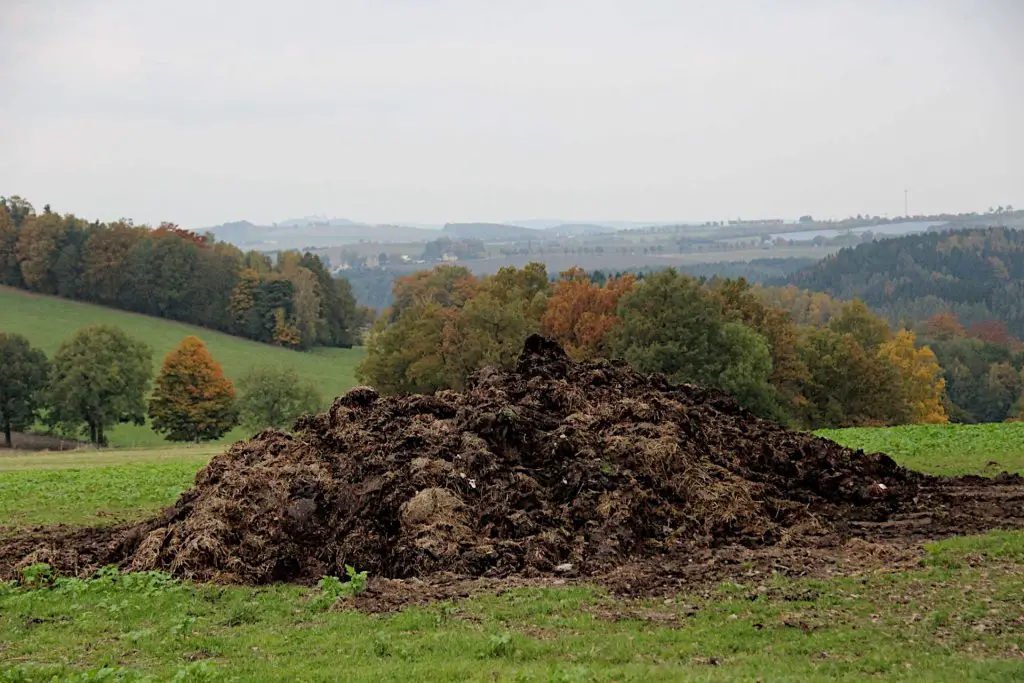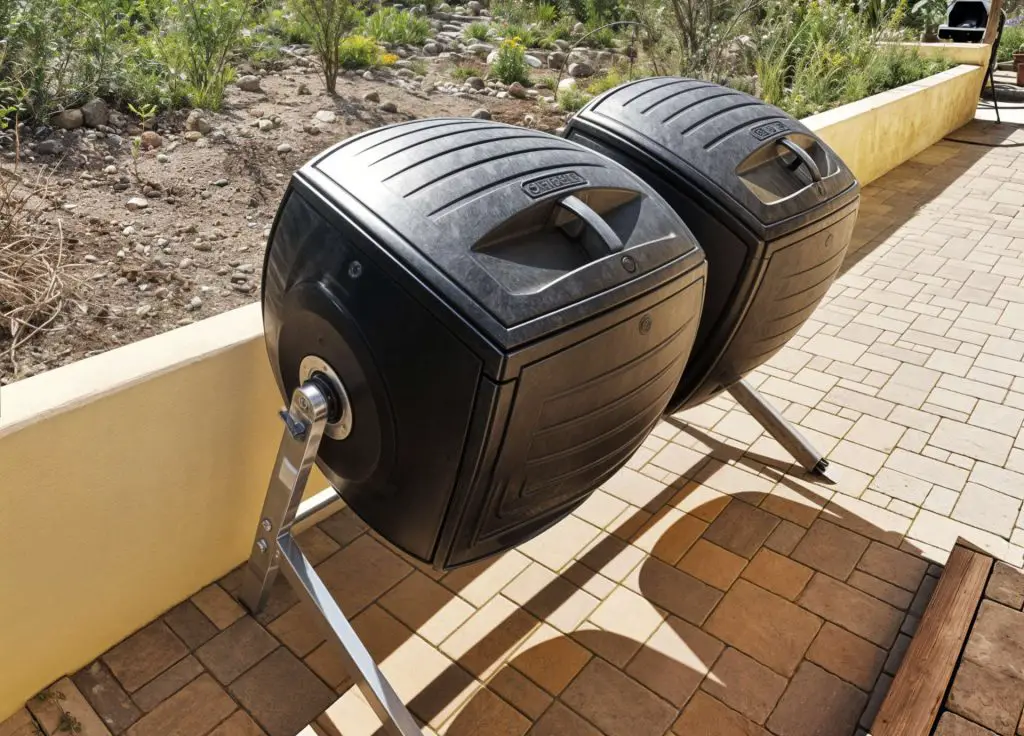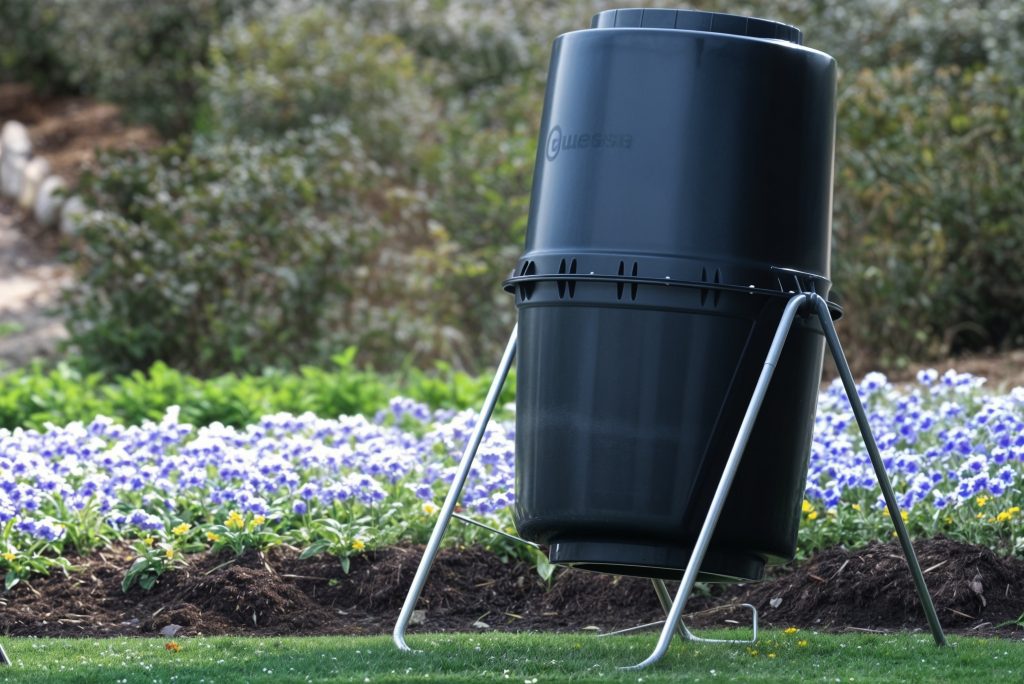Compost Tumblers: Your Key to Easy and Efficient Gardening
Did you know that you can transform your garden’s leftovers into black gold with nothing more than a simple twist. That’s the magic of compost tumblers. These handy devices not only streamline the composting process but also integrate seamlessly into any gardener’s routine, regardless of their space or experience. For those intrigued by sustainable gardening, a compost tumbler could be the key to unlocking a more fruitful and vibrant garden.
Gone are the days of bulky, static compost bins that take up space and require constant attention. Modern compost tumblers fit neatly into small corners, turn kitchen scraps into nutrient-rich soil, and make composting an almost hands-free endeavor. Whether you manage a sprawling vegetable bed or a modest balcony garden, understanding the ease and efficiency of compost tumblers will change how you view waste and renewal in your gardening practice.
What Are Compost Tumblers

A compost tumbler is a barrel-like device that simplifies the traditional composting process, offering gardeners a more efficient and manageable method to recycle organic waste. Unlike the open compost heaps that require manual turning and are often an invitation to pests, these tumblers are enclosed systems that sit on a frame, allowing them to be easily rotated.
What Sets Compost Tumblers Apart?
The primary appeal of a compost tumbler is its design. Enclosed, elevated, and often featuring aeration systems, these tumblers accelerate the decomposition process through increased heat and consistent mixing of materials. By simply turning the handle, gardeners ensure that green materials like vegetable scraps mix thoroughly with brown materials such as dried leaves, speeding up the breakdown into compost.
The Benefits of Elevated Composting
Positioned off the ground, compost tumblers prevent common ground pests like rodents and insects from accessing the contents. This design not only discourages pests but also reduces the risk of plant diseases returning to the garden through the compost. Moreover, the elevated design means less bending and physical strain, making it ideal for gardeners who find frequent bending challenging.
Efficiency and Convenience
One of the standout features of using a compost tumbler is its efficiency. The contained environment helps retain heat and moisture, which are crucial for quick composting. This can cut down the composting process from a year to just a few months, depending on conditions and materials used. Furthermore, the convenience of a tumbler’s rotating mechanism means less effort and time spent maintaining the compost, making it a favorite among those with busy lifestyles or smaller garden spaces.
Innovation in Composting
Recent advancements in compost tumbler designs include improved aeration systems, easier-to-turn barrels, and dual-chamber models that allow for continuous composting cycles. These innovations not only enhance the practicality of compost tumblers but also cater to the diverse needs of modern gardeners, promoting more sustainable gardening practices.
Why Choose a Compost Tumbler?

When it comes to composting, the methods and tools you choose can greatly influence your gardening experience and outcomes. Compost tumblers offer a range of advantages that not only simplify the composting process but also enhance the overall health of your garden.
Ease of Use and Physical Ease
One of the foremost reasons to opt for a compost tumbler is the ease of use. These units are designed to be user-friendly, requiring minimal physical effort. With features like a turning mechanism, gardeners can mix their compost without the strenuous activity of shoveling or the use of pitchforks. This is particularly beneficial for those who want to avoid heavy lifting or who have limited mobility.
Speedier Composting Process
Compost tumblers create ideal conditions for rapid decomposition. By maintaining higher temperatures and consistent moisture levels inside the sealed barrel, these devices can turn organic waste into ready-to-use compost in as little as a few weeks. This is a stark contrast to traditional methods, where compost can take several months to over a year to mature. Such efficiency is invaluable for gardeners who wish to quickly cycle nutrients back into their soil.
Pest and Odor Control
Another significant benefit of using a compost tumbler is the containment of odors and the prevention of pests. The enclosed structure helps to lock in odors that might otherwise attract pests like rodents and flies. This containment is crucial for gardeners who live in urban areas or those who prefer to keep their gardening spaces neat and tidy.
Environmental Impact
Using a compost tumbler also aligns with eco-friendly gardening practices. These systems encourage the recycling of kitchen scraps and yard waste, reducing landfill use and the emission of methane, a potent greenhouse gas. By composting, gardeners contribute to soil enrichment without the use of chemical fertilizers, promoting a healthier ecosystem.
Adaptability to Various Garden Sizes
Whether you have a small patio garden or a large backyard plot, compost tumblers come in sizes to fit any space. Their compact design makes them ideal for urban gardeners or those with limited outdoor areas. Additionally, the portability of many models means they can be easily moved to suit changes in the garden layout or to take advantage of varying sunlight patterns through the seasons.
Choosing a compost tumbler is usually a practical decision for modern gardeners. It simplifies the composting process, accelerates garden productivity, and supports sustainable practices, all while being adaptable to a variety of living environments and gardening scales.
Winter Composting
Composting during the winter months poses unique challenges, but with a compost tumbler, you can continue to produce valuable compost even in colder weather. Tumblers are particularly effective in winter because they provide insulation that retains heat better than open bins. This contained environment helps maintain the microbial activity necessary for decomposition, even as temperatures drop.
Choosing the Right Compost Tumbler for Your Garden

Selecting the ideal compost tumbler involves more than just picking the first option you come across. It requires consideration of your garden’s specific needs, including size, the volume of organic waste typically produced, and even your physical ability to handle the equipment. Here’s how to make the right choice.
Assessing Your Garden’s Size
The size of your garden directly influences the size of the compost tumbler you should choose. For smaller gardens or limited spaces like balconies, a compact tumbler with a capacity of around 30-50 gallons might be perfect. These smaller units are easier to manage and turn, yet still provide sufficient compost for garden beds and container plants.
For larger gardens that generate more organic waste, a tumbler of 60 gallons or more may be necessary. Larger tumblers can handle more material, which means you’ll be able to compost greater volumes of garden and kitchen waste efficiently.
Material and Durability
Compost tumblers come in various materials, each offering different benefits and challenges. Plastic tumblers are lightweight and easy to move but might not insulate heat as well as metal tumblers. Metal tumblers, while heavier, typically offer greater durability and better heat retention, speeding up the composting process. When choosing the material, consider the climate of your area and the ease with which you can maneuver the unit.
Sun Exposure and Placement
The location of your compost tumbler can affect its efficiency. For optimal performance, place your tumbler in a spot that receives adequate sunlight. The heat from the sun aids in maintaining high temperatures inside the tumbler, which accelerates the decomposition process. However, too much direct sunlight might dry out the compost too quickly, especially in warmer climates, so some shade during the hottest part of the day can be beneficial.
Ease of Use
Consider tumblers with features that make composting more manageable. Models with a crank handle allow for easier turning, which is crucial as the tumbler becomes heavier with waste. Dual-chamber tumblers enable continuous composting; while one chamber is “cooking,” you can add fresh materials to the other. This feature is particularly useful for gardeners who produce a steady amount of waste and need a constant supply of compost.
Aeration and Drainage
Good aeration is key to successful composting. Look for tumblers with aeration holes or vents designed to provide adequate air circulation, which helps control moisture and odor. Additionally, check for models with proper drainage to prevent water accumulation, which can lead to overly soggy compost and less effective decomposition.
Getting the Most Out of Your Compost Tumbler

Once you’ve selected the perfect compost tumbler for your garden, the next step is to maximize its potential. Here are some practical tips on how to get started and keep your composting process running smoothly.
Starting Your Compost Tumbler
Begin by adding a balanced mix of nitrogen-rich green materials and carbon-rich browns. Green materials can include kitchen scraps like vegetable peelings, fruit waste, and coffee grounds, while browns might consist of dried leaves, straw, and shredded newspaper. This balance is crucial as it ensures a good supply of nutrients and helps maintain the necessary air pockets in the compost.
Optimal Filling
Avoid overloading your tumbler. A good rule of thumb is to fill it two-thirds full; this allows ample room for turning and aeration, which is key to speeding up the decomposition process. Overfilling can lead to slower decomposition and makes turning the tumbler more difficult.
Regular Turning
One of the biggest advantages of a compost tumbler is the ease of turning. Regular turning—ideally every two to three days—helps mix the compost and distribute moisture and air evenly throughout the pile. This action is essential for aerating the compost and breaking down the materials more quickly.
Monitoring Moisture Levels
The moisture content of your compost should resemble a wrung-out sponge. If the compost is too dry, microbial activity slows down, delaying the composting process. If it’s too wet, it can become smelly and slow to decompose. Adjust moisture levels by adding dry browns if too wet or a sprinkle of water if too dry.
Temperature Checks
The heat generated by microbial activity is a good indicator of the composting process’s efficiency. Compost should feel warm to the touch. If not, it may need more green materials, or it might require better aeration. Monitoring the temperature can help you adjust your balance of materials and turning frequency to optimize the decomposition process.
Troubleshooting Common Issues
Even with the best setup and intentions, you might encounter some challenges while using your compost tumbler. Here are common issues that gardeners face and how to effectively address them to keep your composting process on track.
#1. Unpleasant Odors
If your compost begins to emit a foul smell, it often indicates an imbalance in the material composition. A compost pile that’s too wet and lacks sufficient browns will become anaerobic and start to smell. To rectify this, add more browns like dried leaves, straw, or shredded paper to absorb excess moisture and reintroduce air into the pile. Regular turning is also crucial to allow gases to escape and oxygen to enter, which helps neutralize odors.
#2. Slow Decomposition
A compost tumbler that seems to be taking forever to break down its contents likely has an imbalance in nitrogen and carbon. This could be due to insufficient green materials, which provide nitrogen. Boosting the amount of green waste like vegetable scraps and grass clippings can reinvigorate the composting process. Also, ensure the compost is moist and well-aerated; adjust by adding water or turning more frequently if necessary.
#3. Excessively Dry Compost
In some climates or during certain times of the year, your compost might dry out too quickly, hindering microbial activity needed for decomposition. If the compost feels dry to the touch and dusty, lightly sprinkle water over it during your next few turns. Be cautious not to add too much water; aim for the consistency of a wrung-out sponge.
#4. Attracting Pests
While compost tumblers are generally excellent at keeping pests at bay, sometimes insects and small rodents find their way in if there are cracks or the tumbler is not sealed properly. Ensure that the tumbler is intact and that lids or doors are securely fastened. If you notice pests, check for and repair any damage to your tumbler, and make sure to not include meat, dairy, or oily foods in your compost, as these can attract unwanted visitors.
#5. Overheating
During the peak of summer, compost tumblers can sometimes get too hot, especially if placed in direct sunlight. This can kill beneficial microbes that are vital for composting. If you suspect your compost is overheating, relocate the tumbler to a partially shaded area or reduce the frequency of turning to allow it to cool down.
#6. Inadequate Compost Quantity
If you find that your compost tumbler produces less compost than expected, consider if you are removing materials before they fully decompose. Allow more time for the compost to mature, and ensure you have a good balance of greens and browns. Remember, good things take time, and compost is no exception.
Beyond the Garden: Other Uses of Compost

Compost enriches not only garden beds but also various other aspects of your outdoor and indoor plant life. Expanding the use of compost beyond traditional garden beds can greatly enhance your environment and promote sustainable practices. Here’s how you can utilize the fruits of your composting labor in other beneficial ways.
#1. Potting Mixes
Mixing homemade compost into your potting soil is a fantastic way to provide potted plants with rich, organic nutrients. A blend of one part compost to three parts potting mix creates an ideal environment for houseplants, herbs, and container gardens. This enriched mix supports strong root development and improves water retention, reducing the need for chemical fertilizers.
#2. Lawn Care
Compost acts as a natural lawn conditioner when applied as a top dressing. Spread a thin layer of fine, sifted compost over your lawn to introduce organic matter into the soil, which improves drainage, encourages healthy grass growth, and naturally suppresses weed development. This application not only revitalizes your lawn but also reduces your dependency on synthetic lawn care products.
#3. Mulching
Use compost as mulch around trees, shrubs, and garden plants. A layer of compost spread around plants helps retain soil moisture, suppress weeds, and regulate soil temperature. As it breaks down, it continues to add nutrients back into the soil, fostering a healthier plant base and vibrant garden ecosystem.
#4. Community Gardening
Sharing your compost with a community garden can help others cultivate their planting areas. This not only aids in community beautification projects but also promotes communal sustainability efforts. Contributing compost can foster a sense of community while encouraging others to participate in environmentally friendly practices.
#5. Educational Projects
If you are teach and are looking for an environmental project then a compost tumbler could be a useful teaching aid in schools or educational workshops. Demonstrating how compost is made and used can educate children and adults alike on the benefits of recycling organic waste and the basics of soil health. This hands-on approach can inspire future generations to embrace composting and sustainable gardening.
#6 Making Your Own DIY Project
If you are handy with tools, constructing your own compost tumbler can be a simple and rewarding DIY project. With basic materials like a large barrel, a metal frame, and some hardware, you can build a customized compost tumbler tailored to your specific needs. his approach not only allows for a deeper connection with the composting process but also offers a sense of accomplishment as you contribute directly to your garden’s sustainability.
